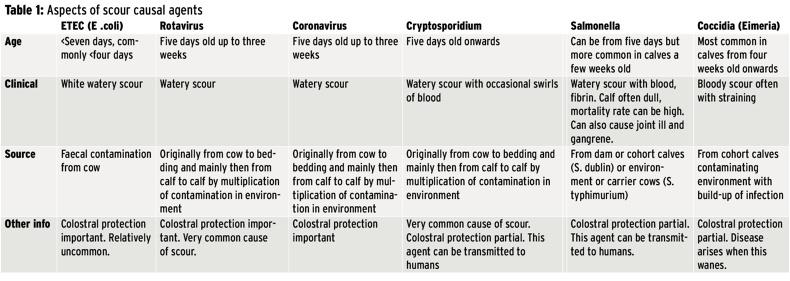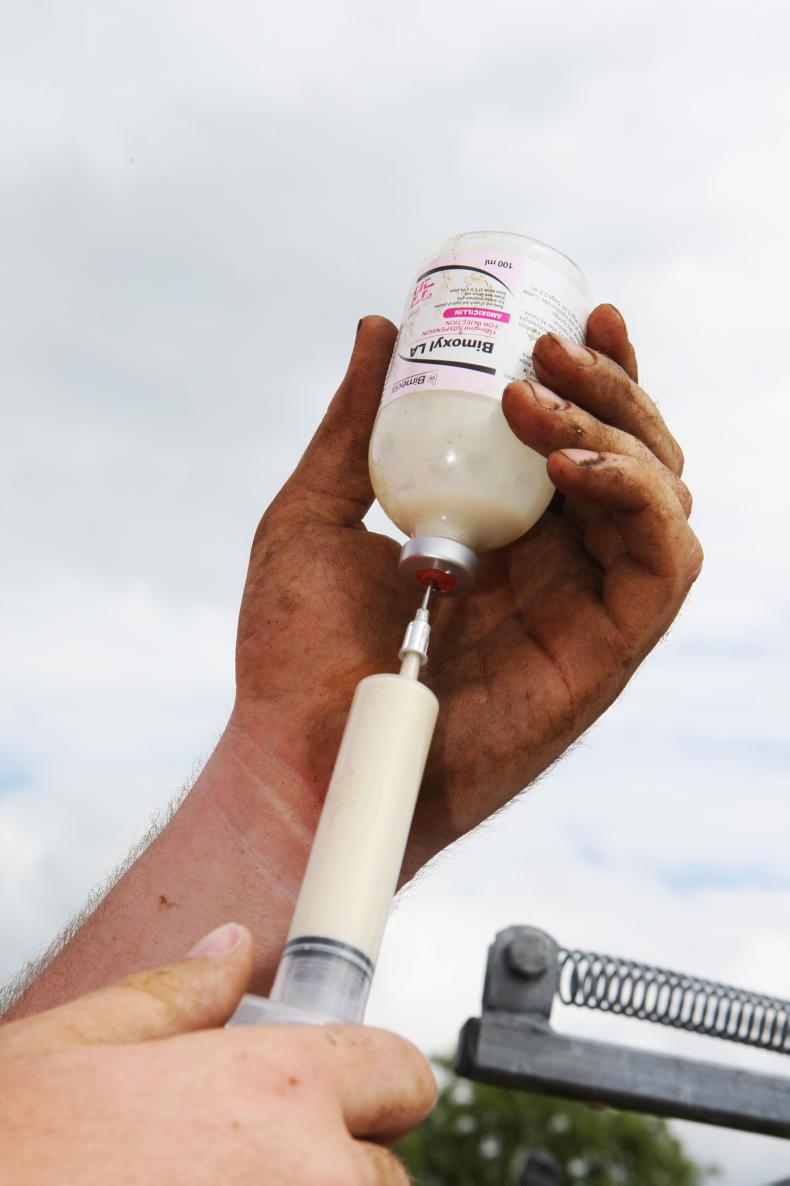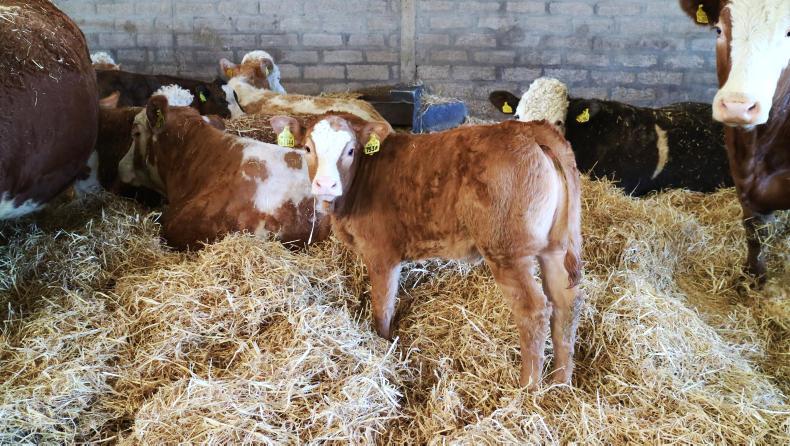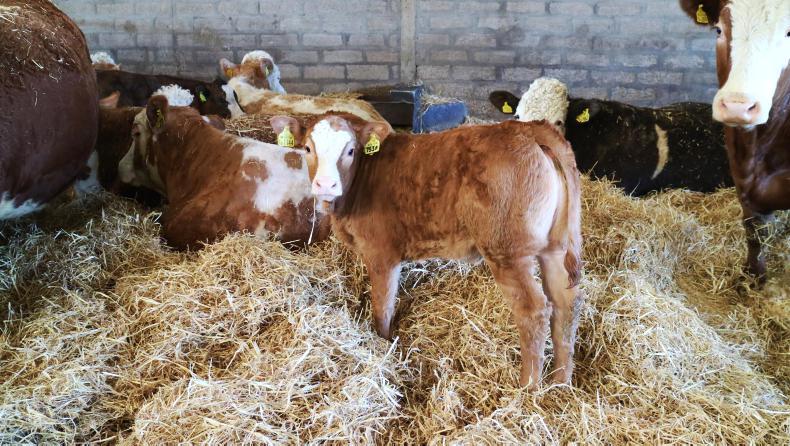Calf diarrhoea in the first three to four weeks of a calf’s life is the leading cause of calf mortality and economic loss for producers of beef and dairy calves (and has been for quite a number of years) in Ireland, according to Department of Agriculture, Food and the Marine statistics.
The costs of treatment or indeed preventive medicines are compounded by a list of other economic losses. These include reduced growth or production in later life, delayed development of affected calves, increased labour costs, the cost of dead calves, lost income from the potential sale of heifers that now have to be retained, a reduction in the rate of genetic improvement, and an increased risk of chemical residues in calves.
An overall scour control plan can be summarised in the word PICTURE. We will look at each of the aspects of this anagram individually as follows:
P – stands for prepare-prevent.
IC – Investigate cause.
T – Treat clinical cases.
U – Undertake further measures when causal agent is identified or deficiencies are discovered in controls.
R – Record incidents of scours, treatments and deaths to provide guidance on performance.
E – Evaluate performance with a view to improving the control plan.
Preparation and prevention (P)
If you have experienced scour problems in the past (or already this season), the key to future success is preparation. Pre-calving nutrition of cows influences the quality and quantity of colostrum produced. Colostrum production and subsequent management is a critical factor in the control of scours (See later). Seek advice from your vet or agricultural/nutritional adviser regarding dry cow nutrition, specifically concerning BCS, energy balance and minerals.
The next step is to address the environment into which the calf will land. Overcrowding, contamination, stress (thermal, if the calves are too cold), nutritional (calves underfed) or poor air quality (including draughts) can all contribute to a scour outbreak.
Address each of these issues in turn in your calf housing. Seek professional advice if necessary as an extra pair of eyes can identify shortcomings that may be overlooked by everyday exposure to the housing environment.
Overcrowding should be avoided by ensuring calves have adequate space. Your agricultural adviser will guide you on this for each phase of calf development. Avoid mixing age groups – aim to have no more than four weeks of an age gap in any group of calves that are mixed together.Hygiene of feeding utensils but also all surfaces with which calves come in contact is critical. I often encounter farmers who are meticulous regarding hygiene of milk buckets yet the calves are maintained in deep-litter bedding – a hotbed of contamination. If you have a history of scour problems, deep-litter bedding should be avoided. Infection breaks can be achieved by a thorough clean-out (and disinfect if possible) on at least a twice-weekly basis. Avoid over-use of the power washer with calves in the house as the excessive damp/humidity can convert a scour problem into a pneumonia outcome. Biosecurity, including foot-baths at entry points to calf housing, separation of young and older calves and quarantining newly purchased cows-calves all play an important role. Ideally, avoid buying in. Rodent control is also important as many agents are disseminated by rats and mice.Avoid stress – have the same person dealing with the calves each day and avoid sudden changes of routine. Nutritional scours often result from rapid changes in replacer feeding brought about by different people doing things in a non-uniform manner. These can predispose to more sinister scours when infections take advantage. Check the mixing capability and temperature of automatic feeders. Like any machine, they need to be checked. Have jackets ready for early-season arrivals. A cold shed (especially at the start of a calving season when calf numbers are low), compounded by poor drainage, leading to damp bedding, can be the difference between calves surviving scour or mortality from hypothermia. Observe calves three times per day as early identification of disease can limit losses and improve treatment success.Identify cause (IC)
In order to understand how to best deal with a scour outbreak, it is important to briefly review the common causes of diarrhoea in calves of this age. There are a number of disease agents that have been consistently identified as significant causes of neonatal calf diarrhoea and mortality can range from 5% to 30%.
Treatment (T)
If calves become dehydrated, they become weak and shocked. While scour should not reach clinical proportions, if all management factors are correct, it is important to have an assigned hospital area to quickly and easily provide warmth (infra-red lamps) and comfort for clinical cases before the season starts. A useful strategy for dealing with the scoury calf is as follows:
Administer a proprietary oral fluid preparation. Avoid giving salt water or glucose water as these can do more harm than good. Consult your vet on the best choice. Aim to administer at least 5% of body weight per day with a top-up depending on how dehydrated the calf is. Many experts now believe that leaving the calf on milk does not alter the outcome.Avoid antibiotics unless absolutely necessary, as most cases of newborn scour are caused by viruses or crypto. There is only one product licensed for the prevention and treatment of cryptosporidiosis – Halocur. It is best administered to all calves from day one to day seven as a preventive product. However, if calves are scouring for less than 24 hours, it may be of some value in treatment. Coccidiosis can be controlled through the use of any of a wide range of products that are indicated for this condition (Baycox, Vecoxan, Deccox, Bovicox, Toltarox, Tratol etc). Salmonellosis will need to be controlled through the use of appropriate effective antibiotics, eg flouroquinolones. Consult your vet for the most appropriate product for your farm.Maintain the calf on electrolytes for less than two days. Thereafter, return the calf to milk only. This can be carried out by mixing subsequent feeds of milk and electrolytes to ease the transition.If the calf deteriorates, consult your vet immediately. Acidosis or electrolyte imbalances may need to be aggressively addressed.If the calf is first noticed recumbent (cannot stand up) consult your vet immediately as these will probably need intravenous drip.Undertake further
control measures (U)
Depending on the causal agent, it may be necessary to make changes. For instance, if coccidiosis is identified, the appropriate products for treatment must be selected, and for salmonellosis, antibiotics are necessary. For cryptosporidiosis or coccidiosis, disinfectants must be selected from a specific list as many are not effective against these agents. Consult your vet for advice in this regard. If problems arise, go back to the drawing board and examine where deficiencies have possibly arisen in preparation and prevention items listed above. If you have bought-in calves, did you buy in more than the calves? It is possible to identify possible sources of breakdown? For example, blood sampling of calves can identify if enough colostrum was given and early enough. Colostrum quality can also be assessed.
Record (R)
Always record all incidents of scour and treatment. This allows comparisons to be made from one season to the next. It allows evaluation of progress and identifies if controls are working (or not).
Evaluate performance (E)
Using the records for the season so far (or at the end of each calving period), look back on how you have done.
Are mortalities, treatments and case numbers improving or going in the wrong direction?
A trend identifies if further attention must be given to the P part of the picture.
A correctly tailored preventive programme that is constantly evaluated and improved has been shown to be very cost-effective, but it takes ongoing continuous effort.

Read more
Special focus: animal health 2017
Calf diarrhoea in the first three to four weeks of a calf’s life is the leading cause of calf mortality and economic loss for producers of beef and dairy calves (and has been for quite a number of years) in Ireland, according to Department of Agriculture, Food and the Marine statistics.
The costs of treatment or indeed preventive medicines are compounded by a list of other economic losses. These include reduced growth or production in later life, delayed development of affected calves, increased labour costs, the cost of dead calves, lost income from the potential sale of heifers that now have to be retained, a reduction in the rate of genetic improvement, and an increased risk of chemical residues in calves.
An overall scour control plan can be summarised in the word PICTURE. We will look at each of the aspects of this anagram individually as follows:
P – stands for prepare-prevent.
IC – Investigate cause.
T – Treat clinical cases.
U – Undertake further measures when causal agent is identified or deficiencies are discovered in controls.
R – Record incidents of scours, treatments and deaths to provide guidance on performance.
E – Evaluate performance with a view to improving the control plan.
Preparation and prevention (P)
If you have experienced scour problems in the past (or already this season), the key to future success is preparation. Pre-calving nutrition of cows influences the quality and quantity of colostrum produced. Colostrum production and subsequent management is a critical factor in the control of scours (See later). Seek advice from your vet or agricultural/nutritional adviser regarding dry cow nutrition, specifically concerning BCS, energy balance and minerals.
The next step is to address the environment into which the calf will land. Overcrowding, contamination, stress (thermal, if the calves are too cold), nutritional (calves underfed) or poor air quality (including draughts) can all contribute to a scour outbreak.
Address each of these issues in turn in your calf housing. Seek professional advice if necessary as an extra pair of eyes can identify shortcomings that may be overlooked by everyday exposure to the housing environment.
Overcrowding should be avoided by ensuring calves have adequate space. Your agricultural adviser will guide you on this for each phase of calf development. Avoid mixing age groups – aim to have no more than four weeks of an age gap in any group of calves that are mixed together.Hygiene of feeding utensils but also all surfaces with which calves come in contact is critical. I often encounter farmers who are meticulous regarding hygiene of milk buckets yet the calves are maintained in deep-litter bedding – a hotbed of contamination. If you have a history of scour problems, deep-litter bedding should be avoided. Infection breaks can be achieved by a thorough clean-out (and disinfect if possible) on at least a twice-weekly basis. Avoid over-use of the power washer with calves in the house as the excessive damp/humidity can convert a scour problem into a pneumonia outcome. Biosecurity, including foot-baths at entry points to calf housing, separation of young and older calves and quarantining newly purchased cows-calves all play an important role. Ideally, avoid buying in. Rodent control is also important as many agents are disseminated by rats and mice.Avoid stress – have the same person dealing with the calves each day and avoid sudden changes of routine. Nutritional scours often result from rapid changes in replacer feeding brought about by different people doing things in a non-uniform manner. These can predispose to more sinister scours when infections take advantage. Check the mixing capability and temperature of automatic feeders. Like any machine, they need to be checked. Have jackets ready for early-season arrivals. A cold shed (especially at the start of a calving season when calf numbers are low), compounded by poor drainage, leading to damp bedding, can be the difference between calves surviving scour or mortality from hypothermia. Observe calves three times per day as early identification of disease can limit losses and improve treatment success.Identify cause (IC)
In order to understand how to best deal with a scour outbreak, it is important to briefly review the common causes of diarrhoea in calves of this age. There are a number of disease agents that have been consistently identified as significant causes of neonatal calf diarrhoea and mortality can range from 5% to 30%.
Treatment (T)
If calves become dehydrated, they become weak and shocked. While scour should not reach clinical proportions, if all management factors are correct, it is important to have an assigned hospital area to quickly and easily provide warmth (infra-red lamps) and comfort for clinical cases before the season starts. A useful strategy for dealing with the scoury calf is as follows:
Administer a proprietary oral fluid preparation. Avoid giving salt water or glucose water as these can do more harm than good. Consult your vet on the best choice. Aim to administer at least 5% of body weight per day with a top-up depending on how dehydrated the calf is. Many experts now believe that leaving the calf on milk does not alter the outcome.Avoid antibiotics unless absolutely necessary, as most cases of newborn scour are caused by viruses or crypto. There is only one product licensed for the prevention and treatment of cryptosporidiosis – Halocur. It is best administered to all calves from day one to day seven as a preventive product. However, if calves are scouring for less than 24 hours, it may be of some value in treatment. Coccidiosis can be controlled through the use of any of a wide range of products that are indicated for this condition (Baycox, Vecoxan, Deccox, Bovicox, Toltarox, Tratol etc). Salmonellosis will need to be controlled through the use of appropriate effective antibiotics, eg flouroquinolones. Consult your vet for the most appropriate product for your farm.Maintain the calf on electrolytes for less than two days. Thereafter, return the calf to milk only. This can be carried out by mixing subsequent feeds of milk and electrolytes to ease the transition.If the calf deteriorates, consult your vet immediately. Acidosis or electrolyte imbalances may need to be aggressively addressed.If the calf is first noticed recumbent (cannot stand up) consult your vet immediately as these will probably need intravenous drip.Undertake further
control measures (U)
Depending on the causal agent, it may be necessary to make changes. For instance, if coccidiosis is identified, the appropriate products for treatment must be selected, and for salmonellosis, antibiotics are necessary. For cryptosporidiosis or coccidiosis, disinfectants must be selected from a specific list as many are not effective against these agents. Consult your vet for advice in this regard. If problems arise, go back to the drawing board and examine where deficiencies have possibly arisen in preparation and prevention items listed above. If you have bought-in calves, did you buy in more than the calves? It is possible to identify possible sources of breakdown? For example, blood sampling of calves can identify if enough colostrum was given and early enough. Colostrum quality can also be assessed.
Record (R)
Always record all incidents of scour and treatment. This allows comparisons to be made from one season to the next. It allows evaluation of progress and identifies if controls are working (or not).
Evaluate performance (E)
Using the records for the season so far (or at the end of each calving period), look back on how you have done.
Are mortalities, treatments and case numbers improving or going in the wrong direction?
A trend identifies if further attention must be given to the P part of the picture.
A correctly tailored preventive programme that is constantly evaluated and improved has been shown to be very cost-effective, but it takes ongoing continuous effort.

Read more
Special focus: animal health 2017











SHARING OPTIONS